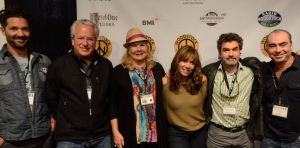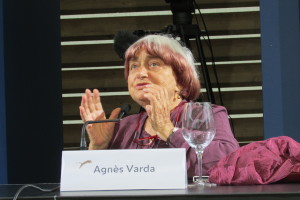Writing the Documentary
You can choose to follow the traditional 3-act structure or a nontraditional narrative format. Or you can choose to present your ideas subjectively or objectively. You can include stock film footage, use talking heads, include yourself in the story, use still photographs, live action, animation, dramatic reenactments, and voiceover narration or let your characters and images alone just tell the story.
You can choose all of the above ideas, some of the above, or none of the above.
Whatever you choose to do in order to convey your story, the execution and clarity will ultimately be vital to the success of your project.
“Making documentaries is a school of life,” stated director Agnès Varda at the 2014 Locarno International Film Festival where I asked her about her writing process. Varda described her style as cinécriture — writing on film. “In The Beaches of Agnès I am turning the mirror to the people who surround me. It shows how you build the life with others.”
At the recent Woodstock Film Festival’s Impact on Filmmaking panel, moderator Robin Bronk asked the panelists how they chose their topics and how film’s narratives evolved.

(left to right: Ali Akbarzadeh, Jon Bowermaster, Anne O’Shea, moderator Robin Bronk, Joe Berlinger, Jedd Wider)
Jedd Wider: “I work with my brother — we produce and direct together. We are very careful at the onset to take on a topic that is going to resonate socially or politically and we need to look inwardly and ask: How do I ensure it is going to be seen? We are motivated by moving the needle in some meaningful way. Our film Mea Maxima Culpa: Silence in the House of God evolved because we didn’t feel that the Vatican was addressing molestation appropriately. We brought on board a New York Times reporter to consult with us, brought on Alex Gibney to direct, and approached HBO: they felt the topic wasn’t addressed appropriately.”
Joe Berlinger: “When we went to do Paradise Lost (The Child Murders at Robin Hood Hills in 1996), it was not about helping the Memphis three. We were initially attracted to the story because all the news coming out of Arkansas was that it was an open and shut case. We were making a film about ‘three kids that were guilty’ — three teens in Arkansas accused of devil worshiping murder, and we went into make this film, thinking, how could kids do such a thing? We spent nine months embedded in the community, waiting for the trial, and spent time with the victims’ families. We realized that despite the media saying this was an open and shut case, we became convinced it was not. Storytelling and advocacy came together, and we hoped it would make a difference. But Damion was sentenced to death, and the film didn’t move the needle, and 18 years later, we made three films and the three guys were finally let out of prison.”
Watch documentaries that share your sensibility, and explore what makes your project different. As you develop your ideas and your interview questions for your subjects, determine what your significant message is, who the main ‘characters’ are and their goals, as well as their possible positive and negative agendas.
Joe Berlinger: “It sounds cliché, but it’s always about the stories and characters. If you want to reach people and have an impact, find a story and find a way to tell it. There needs to be a great character.”
Whether you leave some elements to chance or you stringently stick to your script, indeed, there is no right or wrong way to write a documentary — but listening to your interviewees, those who know your subject matter, and/or just being present in the location of the filming, the opportunity for more ideas might just further enhance your story and film.
Susan Kouguell, award-winning screenwriter and filmmaker, teaches screenwriting at Purchase College, and is the author of SAVVY CHARACTERS SELL SCREENPLAYS! A comprehensive guide to crafting winning characters with film analyses and screenwriting exercises and THE SAVVY SCREENWRITER: How to Sell Your Screenplay (and Yourself) Without Selling Out!. As chairperson of Su-City Pictures East, LLC, a motion picture consulting company founded in 1990, Kouguell works with over 1,000 writers, filmmakers, executives and studios worldwide. Her short films are in the Museum of Modern Art’s permanent collection and archives, and were included in the Whitney Museum’s Biennial. Kouguell worked on Louis Malle’s And the Pursuit of Happiness, was a story analyst and story editor for many studios, wrote voice-over narrations for (Harvey Weinstein) Miramax and over a dozen feature assignments for independent companies. www.su-city-pictures.com; https://su-city-pictures.com/wpblog/
